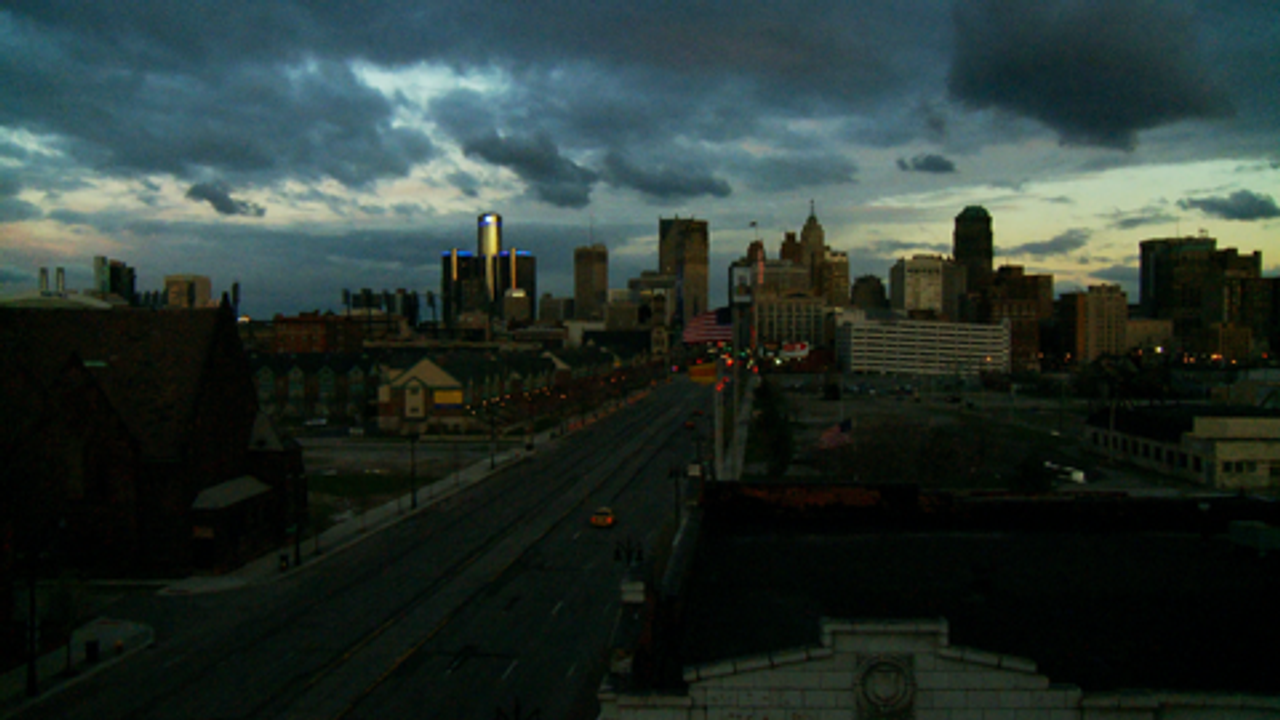Directed by Heidi Ewing and Rachel Grady
The dismantling of Detroit is the subject of Detropia, Heidi Ewing and Rachel Grady’s new documentary.
 A scene from Detropia [Photo: Craig Atkinson]
A scene from Detropia [Photo: Craig Atkinson]
An early scene shows a giant backhoe busying itself with the demolition of a Detroit home whose yard is overgrown with weeds. A television crew follows the action as the newsman intones, “These houses are going and never coming back.” Workers explain that the process goes on, day after day, abandoned house after abandoned house.
Titles point to the extent of Detroit’s collapse. In little more than a generation, the city’s population has fallen by more than half, and continues to decrease.
In its most striking moments, Detropia presents powerful visual evidence of the once-vibrant automaking center’s intense decline. The images of industrial and architectural decay can’t help but evoke an emotional response. Moreover, Ewing and Grady are clearly sympathetic to Detroit’s beleaguered population.
The documentary avoids the most obvious clichés. Culture, for example, is not absent in this portrait of Detroit. Detropia opens with a scene of the symphony and the hard fight to sustain a flourishing opera company attracts the attention of the filmmakers.
Of course, the truth does not show up by itself, even in dramatic images. Once-majestic buildings, now crumbling and graffiti-covered, can’t tell the whole story, which has to be gleaned from the experiences of the human beings who once inhabited or worked in them.
So, the choice of narrators in Detropia is not insignificant. Ewing and Grady choose three principal guides to the city’s crisis: George McGregor, president of United Auto Workers (UAW) Local 22, Tommy Stevens, proprietor of the blues bar Raven Lounge, and Crystal Starr, a video blogger and barista at a downtown coffee shop.
 Crystal Starr in a scene from Detropia [Photo: Tony Hardmon]
Crystal Starr in a scene from Detropia [Photo: Tony Hardmon]
In an interview with New American City, Ewing explained a little about the filmmakers’ process of selecting their storytellers. “We asked everyone for 10 names of people we should meet. By asking questions we started meeting people, having a beer, having a coffee. We arrived at this handful of characters because all of them love this city, but are frustrated and concerned. They are interconnected in a strange way. And they are articulate and funny, survivors and victims of a one-industry town.”
No doubt, the informality of the process has a certain charm, but its arbitrariness also stands out. How do we or the filmmakers know that these individuals are in any way authoritative, or that their views are anything more than random or even self-serving opinion?
McGregor, the union official, describes Detroit’s palmier days as he cruises through the city’s center in his Cadillac. He points out the empty plot of land where General Motors’ Cadillac Assembly Plant used to stand and drives by the large empty buildings of the American Axle Plant, noting that the jobs were shipped to Mexico.
McGregor’s membership works at GM’s Hamtramck Assembly Plant, once called the Poletown Plant, building the Chevrolet Volt. The camera is present when the Local 22 president informs union members of GM’s contract proposal calling for substantial cuts in wages, health care and pensions. One stunned worker says, “Why? What do you think we’re going to feel every day going in to work?” The local membership votes to send the proposal back without even voting on it.
Stevens is shown running his club in Detropia. He dons an apron and prepares food in the kitchen as he talks. Business isn’t so good, but he is determined to hold out until things turn the corner.
Attending the North American International Auto Show with his wife, Tommy is particularly interested in the Chevrolet Volt, the new electric car, built only a few blocks from his bar. He views Detroit’s future as linked to this new technology, but is disappointed to see that a Chinese electric car in the show has twice the range per charge and will cost half the price.
This provokes a discussion later between Tommy and his wife. How can we compete with that? Will we have to work for the same wages as the Chinese?
Video blogger Starr actively concerns herself with the plight of the city. She attends the town hall meetings on Mayor Dave Bing’s relocation plan for Detroit neighborhoods and listens to residents speaking out in protest.
In the course of the gathering, Starr asserts, apparently to her own cellphone camera, “I don’t know if you all understand, but they’re shutting down schools. They’re shutting down . . . the future.”
In response to the audience’s anger at his plan, Bing, the multi-millionaire mayor, remarks coldly, “I don’t know how many times I have to say this. The city is broke.”
 Detropia directors Heidi Ewing and Rachel Grady
Detropia directors Heidi Ewing and Rachel Grady
Detropia portrays the ravaging of Detroit and its population as the genuine historic and human tragedy it is. The central weakness of the film, however, stems from the difficulty Ewing and Grady have in truly digging into and coming to grips with the social and economic processes at work.
Detroit’s protracted “fall” is bound up with the historic deterioration of American capitalism as a whole, with all its earthshaking implications. Unprepared or unable to grapple with these bigger questions, the film, almost by default, ends up adopting the limited (or worse) outlook of its principal talking heads.
The UAW’s McGregor is affable enough, but his standpoint is nationalist and reactionary. Obliged to give his members the bad news from GM, the union official doesn’t really fault the auto giant. The real culprit is the global economy and the Mexicans who take American jobs, he implies.
Of course, the global economy is the culprit, but there are two possible responses: the unity of US, Mexican, South Korean, German and Brazilian workers against GM and the auto companies … or the pitting of workers in one country against those of every other nationality in a race to the bottom. McGregor and UAW have enthusiastically adopted the second course.
Detropia’s real-life characters seem to be in a daze—stunned at what has become of their city and their lives. Tommy, the bar owner, opines that the middle class should be the “buffer” between the very rich and the poor. Without it, he says, there is only revolution. He identifies himself with the disappearing middle class. His club is adorned with Barack Obama paraphernalia.
Three young men sitting on a Detroit porch bring wit and intelligence to the narrative, and a glimpse of real working class life. They mock the idea of urban farming. “Hey! Drop the tomato!” they laugh, parodying a hold-up.
Crystal, the blogger, seems to have something to say. She attends events where she may get a chance to hear people speak out, but her understanding of the social processes as a whole is limited.
The picturesque ruins of a city—an industrial center—attract artists. This is perhaps the murkiest element in the film. It is unclear whether the film is suggesting an influx of artists will be one of the means of saving Detroit. If so, we’ve heard this kind of thing before.
Perhaps the filmmakers too are in something of a daze. The collapse of Detroit is an immense and perplexing phenomenon. Their bewilderment, in part, reflects a larger, popular bewilderment. However, the responsibility of the artist, in the end, is not simply to reflect or pass on confusion, but to get to the bottom of things, including complex and difficult things.
The rather hopeless note on which the film ends is bound up with, in large measure, a lack of insight into the historical and social dynamic. Detroit has an immense history of struggle. The willingness to engage in titanic battles, as in the 1930s, has not gone away.
Even under the recent difficult conditions, workers at American Axle in 2008, the musicians of the Detroit Symphony Orchestra in 2010-11, demonstrated that combativity. An understanding of how these struggles were isolated and defeated, above all, by the UAW and the official “labor” movement, would help shed light on the present circumstances of the working class in Detroit and the city’s condition as a whole.
